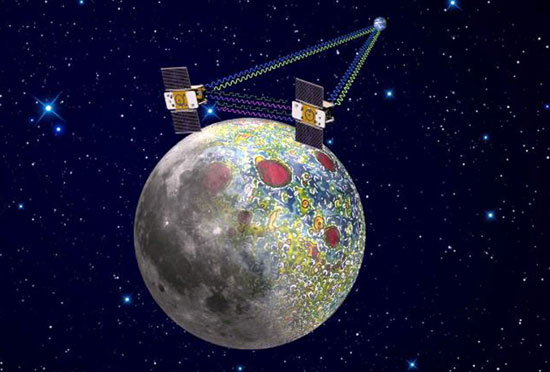NASA 'moon' twins
Nasa's pair of 'twin' spacecraft called GRAIL-A and GRAIL-B was launched on the moon in September 30 and October 5 respectively. The spacecraft attached to the rocket is responsible for adjusting the trajectory of the flight as it moves from the earth to the moon.

By using a highly accurate flight technique, NASA 'twin twin' GRAIL will map the gravitational attraction of the moon so far. (Photo: NASA / JPL-Caltech )
David Lehman, project manager at NASA's Jet Propulsion Laboratory in Pasadena, California, said: " Both spacecraft are operating normally and everything is always under control. There is still a long distance. it is possible to reach the moon's orbit but things are going very well . '
Grail-B was launched at 11:00 am PDT (02 pm EDT) on October 5. The spacecraft's main engine burned 8.2 pounds (3.7 kg) of fuel in 234 seconds, push the spacecraft to reach 56.1 mph (25.1 m / s). Earlier, at 11 am PDT on September 30, the GRAIL-A ship was also launched to the moon, burning 4 pounds (1.87 kg) of fuel for 127 seconds and reaching a speed of 31.3 mph ( 14 m / s).
Scientists have calculated the distance between the launch of Grail-A and Grail-B so that these two ships reach the moon about a day apart, and control them into flying orbits to reach the moon. .
The distance from the earth to the moon is about 250,000 miles (402,336 km). NASA's Apollo crew took about three days to measure this distance. Each spaceship in the Grail ' twin ' pair takes more than 3 months to reach the moon during a journey of about 4,000,000 km.
Flying trajectories have low energy, long journeys that give scientists more time to inspect ships, plan missions and control flight routes in the most accurate way. We must mention the Ultra oscillator stabilizer - an important component of the spacecraft's machinery system, which works continuously for several months, allowing the spacecraft to reach a pre-stable operating temperature. When starting to collect scientific measurements in the moon's orbit.
Grail-A is expected to enter the moon's orbit on New Year's Eve this year, and Grail-B will arrive the next day. When starting to collect data, the spacecraft will transmit radio signals that accurately determine the distance with the moon's orbit. This distance may vary slightly in different regions in the Moon's gravitational field. Scientists will use accurate measurements to calculate and produce final data. This will help us to better understand what lies beneath this celestial surface, its formation and development.
- True stories about twins
- Interesting things about twins that you may not know yet
- Thousands of twins
- Twins are still different in their genes
- What happens when the twins' children get married?
- NASA revealed the time of the first immigration settlement on the Moon
- Why are we twins?
- Twins often live long
- Miraculously twins are born 24 hours apart
- The truth about the mysterious relationship between twins
- Video: Twins kick together to win space in the womb
- Hearing that Russia will go to the Moon to check, NASA rushes to prepare to send people to the Moon again
 Van Allen's belt and evidence that the Apollo 11 mission to the Moon was myth
Van Allen's belt and evidence that the Apollo 11 mission to the Moon was myth The levels of civilization in the universe (Kardashev scale)
The levels of civilization in the universe (Kardashev scale) Today Mars, the sun and the Earth are aligned
Today Mars, the sun and the Earth are aligned The Amazon owner announced a secret plan to build a space base for thousands of people
The Amazon owner announced a secret plan to build a space base for thousands of people